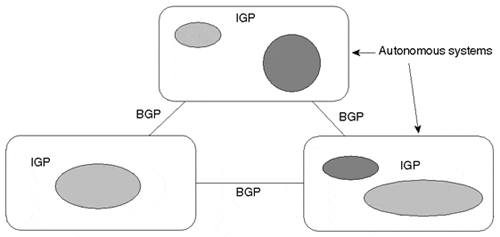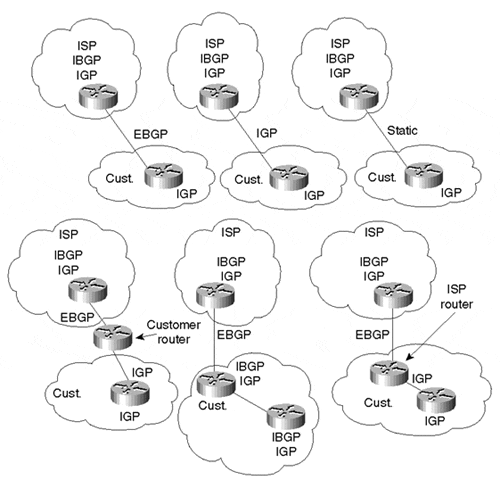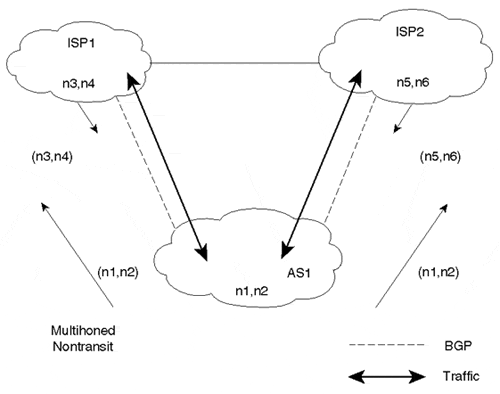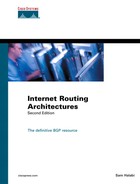Segregating the World into Autonomous Systems
Exterior routing protocols were created to control the expansion of routing tables and to provide a more structured view of the Internet by segregating routing domains into separate administrations, called autonomous systems (ASs), which each have their own independent routing policies and unique IGPs.
During the early days of the Internet, an exterior gateway protocol called EGP[8] (not to be confused with Exterior Gateway Protocols in general) was used. The NSFNET used EGP to exchange reachability information between the backbone and the regional networks. Although the use of EGP was widely deployed, its topology restrictions and inefficiency in dealing with routing loops and setting routing policies created a need for a new and more robust protocol. Currently, BGP-4 is the de facto standard for interdomain routing in the Internet.
Note
Note that the primary difference between intra-AS and inter-AS routing is that intra-AS routing is usually optimized in accordance with the required technical demands, while inter-AS usually reflects political and business relationships between the networks and companies involved.
Static Routing, Default Routing, and Dynamic Routing
Before introducing and looking at the basic ways in which autonomous systems can be connected to ISPs, we need to establish some basic terminology and concepts of routing:
-
Static routing refers to routes to destinations being listed manually, or statically, as the name implies, in the router. Network reachability in this case is not dependent on the existence and state of the network itself. Whether a destination is active or not, the static routes remain in the routing table, and traffic is still sent toward the specified destination.
-
Default routing refers to a "last resort" outlet. Traffic to destinations that is unknown to the router is sent to that default outlet. Default routing is the easiest form of routing for a domain connected to a single exit point.
-
Dynamic routing refers to routes being learned via an interior or exterior routing protocol. Network reachability is dependent on the existence and state of the network. If a destination is down, the route disappears from the routing table, and traffic is not sent toward that destination.
These three routing approaches are possibilities for all the AS configurations considered in forthcoming sections, but usually there is an optimal approach. Thus, in illustrating different autonomous systems, this chapter considers whether static, dynamic, default, or some combination of these is optimal. This chapter also considers whether interior or exterior routing protocols are appropriate. However, a more detailed exploration of routing choices for different AS topologies will not be discussed until Chapter 6, "Tuning BGP Capabilities."
Always remember that static and default routing are not your enemy. The most stable (but sometimes less flexible) configurations are based on static routing. Many people feel that they are not technologically up to date just because they are not running dynamic routing. Trying to force dynamic routing on situations that do not require it is a waste of bandwidth, effort, and money. Recall the KISS principle introduced in the preceding chapter!
Autonomous Systems
An autonomous system (AS) is a set of routers that has a single routing policy, that run under a single technical administration, and that commonly utilizes a single IGP (the AS could also be a collection of IGPs working together to provide interior routing). To the outside world, the entire AS is viewed as a single entity. Each AS has an identifying number, which is assigned to it by an Internet Registry, or a service provider in the instance of private ASs. Routing information between ASs is exchanged via an exterior gateway protocol such as BGP-4, as illustrated in Figure 4-2.
Figure 4-2. Routing Information Exchange Between Autonomous Systems

What we have gained by segregating the world into administrations is the capability to have one large network (in the sense that the Internet could have been one huge OSPF or IS-IS network) divided into smaller and more manageable networks. These networks, represented as ASs, can now implement their own set of rules and policies that will uniquely distinguish their networks and associated service offerings from other networks. Each AS can now run its own set of IGPs, independent of IGPs in other ASs.
The next few sections discuss potential network configurations with stub (single-homed) networks, multihomed nontransit networks, and multihomed transit networks.
Stub AS
An AS is considered stub when it reaches networks outside its domain via a single exit point. These ASs are also referred to as single-homed with respect to other providers. Figure 4-3 illustrates a single-homed or stub AS.
Figure 4-3. Single-Homed (Stub) AS

A single-homed AS does not really have to learn Internet routes from its provider. Because there is a single way out, all traffic can default to the provider. When using this configuration, the provider can use different methods to advertise the customer's routes to other networks.
One possibility is for the provider to list the customer's subnets as static entries in its router. The provider would then advertise these static entries toward the Internet via BGP. This method would scale very well if the customer's routes can be represented by a small set of aggregate routes. When the customer has too many noncontiguous subnets, listing all these subnets via static routes becomes inefficient.
Alternatively, the provider can employ IGPs for advertising the customer's networks. An IGP can be used between the customer and provider for the customer to advertise its routes. This has all the benefits of dynamic routing where network information and changes are dynamically sent to the provider. This is very uncommon, however, primarily because it doesn't scale well because customer link instability can result in IGP instabilities.
The third method by which the ISP can learn and advertise the customer's routes is to use BGP between the customer and the provider. In the stub AS situation, it is hard to get a registered AS number from an IRR because the customer's routing policies are an extension of the policies of a single provider.
Note
RFC 1930[9] provides a set of guidelines for the creation, selection, and registration of autonomous system numbers.
Instead, the provider can give the customer an AS number from the private pool of ASs (65412–65535), assuming that the provider's routing policies have provisioned support for using private AS space with customers, as described in RFC 2270[10].
Quite a few combinations of protocols can be used between the ISP and the customer. Figure 4-4 illustrates some of the possible configurations, using just stub ASs as an example. (The meaning of EBGP and IBGP will be discussed in upcoming sections.) Providers might extend customer routers to their POPs, or providers might extend their routers to the customer's network. Note that not every situation requires that a customer run BGP with its provider, as mentioned earlier.
Figure 4-4. Stub ASs: Sample Protocol Implementation Variations

Multihomed Nontransit AS
An AS is multihomed if it has more than one exit point to the outside world. An AS can be multihomed to a single provider or multiple providers. A nontransit AS does not allow transit traffic to go through it. Transit traffic is any traffic that has a source and destination outside the AS. Figure 4-5 illustrates an AS (AS1) that is nontransit and multihomed to two providers, ISP1 and ISP2.
Figure 4-5. Multihomed Nontransit AS Example

A nontransit AS would only advertise its own routes and would not propagate routes that it learned from other ASs. This ensures that traffic for any destination that does not belong to the AS would not be directed to the AS. In Figure 4-5, AS1 learns about routes n3 and n4 via ISP1 and routes n5 and n6 via ISP2. AS1 advertises only its local routes (n1,n2). It does not pass to ISP2 the routes it learned from ISP1 or to ISP1 the routes it learned from ISP2. This way, AS1 does not open itself to outside traffic, such as ISP1 trying to reach n5 or n6 and ISP2 trying to reach n3 and n4 via AS1. Of course, ISP1 or ISP2 can force its traffic to be directed to AS1 via default or static routing. As a precaution against this, AS1 could filter any traffic coming toward it with a destination not belonging to AS1.
Multihomed nontransit ASs do not really need to run BGP with their providers, although it is recommended and most of the time is required by the provider. As you will see later in this book, running BGP-4 with the providers has many advantages as far as controlling route propagation and filtering.
Multihomed Transit AS
A multihomed transit AS has more than one connection to the outside world and can still be used for transit traffic by other ASs (see Figure 4-6). Transit traffic (relative to the multihomed AS) is any traffic that has an origin and destination that does not belong to the local AS.
Although BGP-4 is an exterior gateway protocol, it can still be used inside an AS as a pipe to exchange BGP updates. BGP connections between routers inside an autonomous system are referred to as Internal BGP (IBGP), whereas BGP connections between routers in separate autonomous systems are referred to as External BGP (EBGP). Routers that are running IBGP are called transit routers when they carry the transit traffic going through the AS.
A transit AS would advertise to one AS routes that it learned from another AS. This way, the transit AS would open itself to traffic that does not belong to it. Multihomed transit ASs are advised to use BGP-4 for their connections to other ASs and to shield their internal nontransit routers from Internet routes. Not all routers inside a domain need to run BGP; internal nontransit routers could run default routing to the BGP routers, which alleviates the number of routes the internal nontransit routers must carry. In most large service provider networks, however, all routers usually carry a full set of BGP routes internally.
Figure 4-6 illustrates a multihomed transit autonomous system, AS1, connected to two different providers, ISP1 and ISP2. AS1 learns routes n3, n4, n5, and n6 from both ISP1 and ISP2 and in turn advertises all that it learns, including its local routes, to ISP1 and ISP2. In this case, ISP1 could use AS1 as a transit AS to reach networks n5 and n6, and ISP2 could use AS1 to reach networks n3 and n4.

